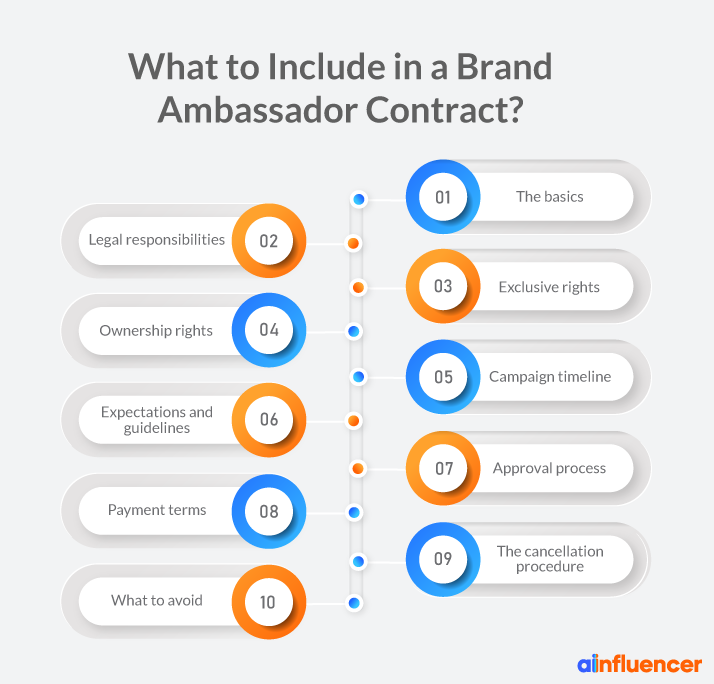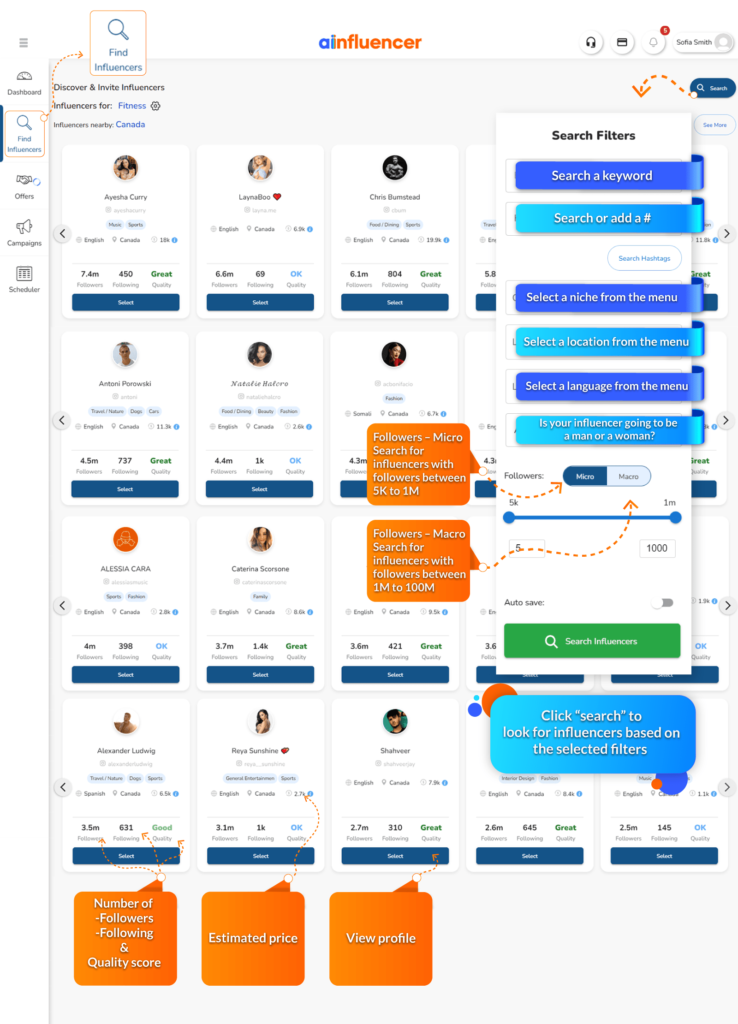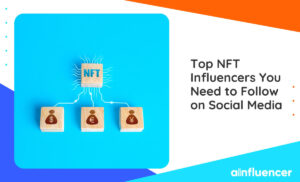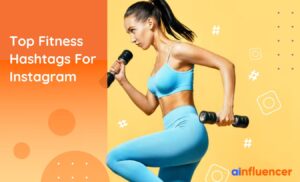Brand ambassadors are an important part of any marketing strategy these days. When a company decides to launch a new product, they often need help getting the word out. That’s where brand ambassadors come in, and as a result, you need to set up a brand ambassador contract.
What is a brand ambassador?
Brand ambassadors are often used to increase brand awareness, promote the brand’s products or services, and influence people’s buying decisions. They also help create a connection between the company and its customers.
Brand ambassadors may be employees of the company, or they may be hired as outside contractors. They are typically paid to promote the brand through social media posts, appearances at events, or by creating content about the brand.
One of the most important things a company can do when hiring a brand ambassador is to have a brand ambassador contract in the first place.
What is a Brand Ambassador Contract?
A brand ambassador contract is a legal agreement between a company and an individual who agrees to represent the company and its products or services.
Brand ambassador contracts outline the expectations and responsibilities of both the company and the ambassador.
They may also specify how much the ambassador will be paid and how long the agreement will last.
Why is it important to have a brand ambassador contract?
When a company is looking to hire a brand ambassador, it is essential that they have a contract in place.
Contracts are an act of professionalism for your brand to ensure that you and your ambassadors act correctly upon stated terms.
Brand ambassador contracts can protect both the company and the ambassador and help brands ensure that the ambassador’s efforts align with the company’s goals.
As well as mentioning the expectations and responsibilities, the contract should also include a term sheet, which outlines the length of the brand ambassador agreement, and the compensation and benefits that will be given to the ambassador.
Now, let’s discuss what you should include in your brand ambassador contract.
What to include in a brand ambassador contract?
Before going any further, when establishing a brand ambassador contract, it is always a good idea to use a brand ambassador contract template to help you save time and remove all the uncertainties of doing everything yourself from scratch.
Moreover, pay attention to the essential things you should include in your brand ambassador contract, which are listed below:

1. The basics
The basic features that should appear on any valid brand ambassador contract are the names of the parties involved, the date you write the contract, and a description of what the contract is about. For example, you can outline that this is a contract between the advertiser and the influencer.
2. Legal responsibilities
Aside from the basic information, there are requirements that ambassadors and brands have to follow when establishing a brand ambassador contract. You and brand ambassadors should follow local marketing laws and regulations.
One of your legal responsibilities is to be aware of any intellectual property rights that the company has in its brand and product names, logos, and slogans.
It is also important to understand what is and is not allowed in terms of promoting the company and its products, and to avoid making any false or misleading statements about them.
3. Exclusive rights
Exclusive rights are used to prevent brand ambassadors from going against contract terms and working with your competitors, which will lead to conflicts later on.
For example, a celebrity chosen to be a brand ambassador for a clothing company may be prohibited from endorsing any other clothing brand.
Many brand ambassadors go against contract terms and promote brands’ competitors’ products. Exclusive rights are included in brand ambassador contracts to solve this problem and avoid any deception from both sides. Also, you can use legal document templates for better results.
4. Ownership rights
Content used by ambassadors is usually of the highest quality, and you may be interested in repurposing this content. Adding terms in the brand ambassador contract to give you the legal rights to use the ambassador’s blogs, articles, and social media posts should be included to avoid any copyright issues.
5. Campaign timeline
A brand ambassador contract has to include a timeline of when content should be published. It can be daily, weekly, or monthly.
The contract should include how long you are thinking of working together and the end date. Always include dates that you and the ambassadors agree on to avoid any future potential conflicts.
Having a set timeline will help you avoid any confusion and stay on track. It would help if you checked a brand ambassador program template to see how you can do so.
6. Expectations and guidelines
When signing a brand ambassador contract, both the company and the ambassador have certain expectations and guidelines to follow.
Contracts with ambassadors should state your expectations of them. For example, which social media platforms should ambassadors use to post content, and how much content should be posted within a specific time frame?
Additionally, ambassadors should follow a set of guidelines established by you, as a brand owner, regarding content.
For example, what kind of descriptions to write, hashtags to use, where to place these hashtags, how content should look, what to mention in the content, and more. This further helps ambassadors reflect what your brand stands for.
Ambassadors may also have some expectations. They expect to be compensated for their work and receive products or gift cards for promotional purposes.
7. Approval process
Before any posts go live, there should be an approval process you should establish with your ambassadors. Monitoring the kind of content that is written should be in line with your brand’s image.
Although, be sure to be clear about your approval process to help ambassadors understand what kind of content you want. This way, you are avoiding any complications and helping brand ambassadors improve with your helpful feedback.
By having a brand ambassador contract template, you can make your own contract so much easier.
8. Payment terms
You would be surprised by how many conflicts occur due to financial disagreements. Never forget to include this part in your brand ambassador contract, and always state payment terms in depth and their timelines (monthly, weekly).
Include the exact amount you’re supposed to pay, as well as the dates when the payment is expected to occur.
9. The cancellation procedure
A brand ambassador contract includes a starting and ending date, which means it won’t last for an eternity.
A procedure should include the steps that must be taken if you or the ambassador want to end the contract. Usually, before a contract ends, both parties should be informed 30 days before its ending period. This gives time for both parties to act and find another option.
Typically, the cancellation procedure will outline specific reasons that either party can use to terminate the contract.
Specify what things break your brand’s rules or are considered poor performance and non-performance.
10. What to avoid
If you don’t state what to avoid doing in your brand ambassador contract, you can’t criticize anybody for why they did something that they weren’t informed about.
Inform your ambassadors what they should avoid doing when working with you, and even include that if they do it, it will lead to contract termination.
For example, your contract may include specific phrases, topics, or words to avoid using, and much more. This enables both parties to correctly and ethically work with each other.
How to find brand ambassadors?
As a brand, it’s essential for you to work with brand ambassadors. Brand ambassadors can be celebrities, influencers, athletes, or other influential people with large audiences on social media platforms.
The important thing before creating a brand ambassador contract is how and where to find the most related ones to your niche.
Here are a few ways to find and recruit them:
- Google: You can easily search on Google for brand ambassadors and come up with countless names.
- Hashtags: You can also search for brand ambassadors by hashtags on Instagram and find them in different niches.
- Marketing platforms: Using marketing platforms and influencer marketplaces is also another possible way to find brand ambassadors. One of the best marketplaces that you can use is Ainfluencer.
Ainfluencer
Ainfluencer is a DIY marketplace full of brands and brand ambassadors ready to connect and collaborate.
Finding influencers in this marketplace is so easy. It is free and user-friendly and lets you search for your targeted brand ambassadors through filters such as gender, location, number of followers, etc.

Check out the following YouTube video to see how you can create your free marketplace ad, explore, filter, and invite qualified influencers with ease on Ainfluencer.
Brand ambassador contract templates
Here are three samples of a brand ambassador contract:
#1 Sample one:
Brand Ambassador Contract
This Agreement is executed on {time} by and between the following:
Brand Ambassador Name —— Company Name
Brand Ambassador Email —— Company Email
Address of Brand Ambassador —— Company Address
- Overview
The Company is engaged in the manufacture and sale of Supernatural Light bulbs that intend to expand its reach for recognition and sales; the Brand Ambassador is a recognized personality and in a position of influence providing reviews and advocating efficient electronic appliances.
The Parties agree and acknowledge that the Brand Ambassador shall perform promotion services in connection with Company through the Company’s social media channels, including but not limited to Twitter, Facebook, Instagram, YouTube, Pinterest, among others.
- Compensation Agreement
As full compensation and consideration for the complete performance of all the work and other obligations under this Agreement and all costs, the parties affirm that Client shall pay the agreed amount of {contract amount} the full (the “Contract Price”) upon the fulfillment of the duties and obligations of the Brand Ambassador.
- Product Use and Ownership
The Brand Ambassador shall be provided products by the Company at no expense for the benefit of the Brand Ambassador. The Brand Ambassador agrees that in such provision of products, the Brand Ambassador cannot and may not subject the products provided for resale.
Should the Brand Ambassador decide to discontinue the use, return, or sell the products, the Brand Ambassador shall notify the Company prior to such action.
- Copyright
The copyright of the work created by the Brand Ambassador shall remain with the Brand Ambassador. Any reproduction of the works after the duration of the Agreement shall require consent from the Brand Ambassador or may require a new agreement between the Company and the Brand Ambassador.
- Confidentiality
The Parties to this Agreement may not disclose to any third party the use of the works engaged by the Brand Ambassador with the Company without the other party’s written consent. Neither Party may sell nor disclose with any third party any proprietary or confidential information acquired by them in the course of their engagement with the other, without the written consent of the other party.
The Brand Ambassador agrees to return to Company all confidential documents, records, or any information owned by the company upon the termination of the Agreement. In case of failure to return the confidential documents, records, or information, the Brand Ambassador shall notify the Company and shall agree on how such information shall be disposed of or returned to the Company.
- Period and Termination
This Contract shall remain effective and enforceable for a period of {time}, beginning on the date of effectivity of this agreement up until the year thereafter, unless prematurely terminated by either party.
Should any party decide to terminate this Agreement prior to the date of maturity, the party shall notify the other at least thirty (30) days prior to the termination date.
- Representations and Warranties
The Company acknowledges and understands that:
- Brand Ambassador has the unrestricted right and authority to perform the duties and deliverables that conform to this Agreement;
- The deliverables by the Brand Ambassador are original;
- All duties and responsibilities by the Brand Ambassador are compliant with the applicable laws, rules, and regulations of the State agreed upon by Parties, to be performed in this Agreement;
- The work of the Brand Ambassador will not contain defamatory, disparaging, or offensive content to any product or business, be involved in any pornographic, or be contrary to any religious beliefs.
- Separability clause
Should any of the provisions of this Agreement be held invalid by any competent court, the same shall apply only to the said provision, and the remaining provisions hereof shall remain valid and enforceable.
- Agreement Modification
No modification or alteration of this contract shall be considered as having been made unless otherwise executed in writing and duly signed by the parties hereto.
- Judicial Action
Any action arising from or brought under this Contract shall be filed with the proper courts of {law Jurisdiction}, to the exclusion of all other venues that are hereby expressly and willingly waived by the parties.
IN WITNESS WHEREOF, the parties hereunto have signed this Agreement on {execution of}.
#2 Sample two:
Brand Ambassador Contract
- Introduction: This contract was made on {date of Contract}. This contract is between the {Influencer’s name} and the {company’s name}.
- Acknowledgment: The advertiser and the influencer acknowledge the terms of this Contract and will comply.
- Terms: This contract will begin on {start date} and will end on {end date}. A new contract will be created for the renewal of the term.
- Payment fees: The total payment will be $ {total payment}. Payment will be made by {payment method}. The payment should be made at the start or during the campaign. The influencer will be liable for paying appropriate taxes.
- Content requirements:
- The influencer should create original content that is decent, honest, and factual.
- An approval from the advertiser is {approval} before uploading the content.
- The approved created content will be shared by the influencer to his/her social media accounts listed above.
- The advertiser can request the influencer to add tags, links, or titles in the description of the uploaded media.
- The content should be compliant with the terms and conditions of the social media platform being used.
- The content should not contain any vulgar language and should be suited for everyone.
- Copyright: The {who Will} will own the copyright of the uploaded media. However, both parties are allowed to share it with their own respective channels.
- Confidentiality: This contract is strictly confidential, and only authorized persons are allowed to see it.
- Amendment: This contract can only be changed or modified through the written consent of both parties (Advertiser and Influencer).
- Governing law: This contract shall be governed under the laws of {address: state} (USA).
#3 Sample three:
Brand Ambassador Agreement
- Parties:
This brand ambassador agreement is created by and between Force Oxford Company, with its principal place of business at 80 Katherine Road, Simi Valley, California 93063 (“Company”), and Scott Hurlbutt (“Ambassador”), made effective on June 25, 2034.
The Company and the Ambassador are each referred to as a “Party” and, collectively, as the “Parties.”
- Scope of work:
The Ambassador, with all its marketing efforts, agrees to represent and promote the Company brand (“Services”) by appearing on the promotional events and posters (“Project”) organized and disseminated by the Company throughout the term of this Agreement.
- Amount:
Upon signing this Agreement, the Ambassador will be compensated a sign-on bonus worth ten thousand dollars ($10,000.00) for agreeing to represent the Company and a service fee of eight thousand dollars ($8,000.00) for rendering the necessary Services requested by the Company under the terms and conditions herein.
- Term and termination:
- This Agreement will be effective on June 25, 2034, and is expected to terminate on June 25, 2035.
- Both Parties reserve the right to file an early termination of this Agreement should either Party conduct unsatisfactory performances in relation to this Agreement.
- Warranties:
- The Ambassador warrants to be professional, punctual, and interactive when conducting Services and appearing on the promotional events organized by the Company.
- The Company commits to provide all equipment and materials necessary for the Ambassador to commence and complete all Projects stated herein throughout the terms of this Agreement.
- General provisions: The Parties agree to indemnify each other for any claims, loss, or damages that may occur in conducting the Services and the Project within this Agreement.
- Any provisions written in this Agreement that become invalid, illegal, or unenforceable will not affect the remaining provisions herein.
- This Agreement must be interpreted under the jurisdiction of the State of California.
IN WITNESS WHEREOF, the Parties agree to abide by the above-mentioned terms upon signing this Brand Ambassador Agreement on this day.
Signatures and names.
Conclusion
Well, that’s about it for this article. Hopefully, you now have a clear picture of what you should do with your brand ambassador contract. Remember that it is better to be legally protected than to come to an agreement that you may get deceived later on.
This article shows you the essential things to include in your contract. Carefully read each step and use a brand ambassador contract template to ensure that you don’t lose much time working on it. It is better to take your time reading than rush it out and not make the contract right.
Read, research, analyze, and make sure you and your brand ambassadors agree on everything before stating the terms. A brand ambassador contract isn’t supposed to go one way, but it is an agreement for partnerships to promote each other. In that case, you are on the road to a great collaboration!
Do not forget to use marketplaces, such as Ainfluencer, to easily find your targeted brand ambassadors.
There are some essential things you should include in your brand ambassador contract:
1. Legal responsibilities
2. Exclusive rights
3. Ownership rights
4. Campaign timeline
5. Expectations and guidelines
6. Approval process
7. Payment terms
8. The cancellation procedure
9. What to avoid
Brand ambassadors are often given free products or discounts in order to promote the company. Some of them are just compensated with free products, while others may get hundreds of thousands of dollars for promoting a product or service.

![Read more about the article 15 Best Black Friday Marketing Strategies [2023 Winning Tips]](https://blog.ainfluencer.com/wp-content/uploads/2022/11/Top-Black-Friday-Marketing-Strategies-1-300x182.png)


![Read more about the article What Is Temu Influencer Program: [How to Join + Best 2024 Alternative]](https://blog.ainfluencer.com/wp-content/uploads/2024/01/temu-featured-1-300x182.jpg)




